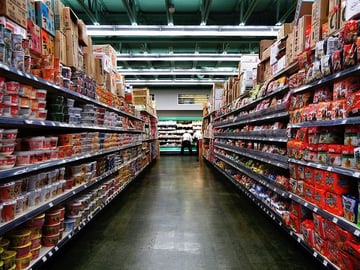From “vegetarian” hot dogs that contain meat to farm-raised salmon being sold as wild-caught, recent details about food contamination and food fraud have the public rightly concerned. Ethical breaches aside, the sheer complexity of modern supply chains leaves food producers and purveyors susceptible to mistakes and inaccurately labeled products.
These problems have shined a light on the organizations that provide DNA testing services on food products. But what exactly does this involve, and what are the implications for supply chain professionals? Read on for background about this trend and tips for how to adapt your business.
What is Food Label DNA Testing?
Companies like Clear Labs, NSF International and Marshfield Food Safety perform DNA sequencing on food samples to identify the plant and animal species present, and determine whether a food or packaged product actually contains the ingredients on its label.
Along with telling us whether a product labeled as chicken really is chicken, these tests can detect things like plant-based allergens or microbes that cause foodborne illnesses. Many of the companies that offer food DNA testing also perform non-DNA tests for things like pesticides, GMOs, hormones, antibiotics and nutrients.
The most common DNA test used on food is Polymerase Chain Reaction, or PCR, which identifies a fragment of DNA by comparing its size to the size of known DNA fragments. Clear Labs uses DNA barcoding, where a short genetic marker, or “barcode,” is identified by comparing against a database of known species’ DNA sequences.
DNA testing is extremely accurate, but it’s not perfect. False positives and cross-contamination are possible, and DNA can’t detect every kind of food fraud or contamination issue. Still, as the technology becomes faster and cheaper, the practice grows more common.
How is it Affecting the Food Industry?
Consumers want accurate food labels, and they’re prepared to reward brands that prove themselves trustworthy.
Companies like Clear Labs seek to arm consumers with as much information as possible. “The co-founders prognosticate a consumer application around five to seven years in the future,” writes Sarah Buhr for TechCrunch. “[Co-founder Mahni Ghorashi] sees a future where you could even take out your smartphone and scan the label of a food item at your grocery store or at a restaurant and being able to see the molecular data and any concerns associated with it before putting it in your mouth.”
The rise in DNA testing has corresponded with an increase in recalls of food and packaged goods, according to Kevin T. Higgins. And in 2015, in response to a state attorney general investigation, specialty retailer GNC agreed to begin advanced DNA testing to verify the authenticity of plants in its herbal supplements and test for common allergens.
The bottom line: This trend puts pressure on food companies to be truthful—which starts with knowing the truth about every ingredient in your supply chain. Publicly traded companies need to show investors they’re striving to mitigate the risks of contamination and inaccurate labeling. Comprehensive food supply chain traceability data can reassure investors and the public of your product’s authenticity and instill trust in your labels.
What Can You Do to Adapt?
- Update your testing processes to leverage the latest technology wherever possible. By proactively ensuring your food labels are as accurate and transparent as possible, you’ll be better positioned to stay a step ahead of the DNA testing trend.
- Know your suppliers so you can be assured you’re working with companies who share your same commitment to quality.
- Communicate incidents of contamination or mislabeling promptly and honestly, and audit your processes to make sure you can execute supply withdrawals efficiently.
- Invest in traceability software to empower your teams with the most accurate, comprehensive view of your ingredients’ path to your facilities and onward to consumers.
Food Label DNA testing is just one more example of the trend toward transparency in the food industry. By having a clearer view into your supply chain, you can make sure there are no hidden secrets.
Interested in learning more about supply chain traceability software and how to make a case to your leadership team? Check out our free guide, Selling the C-Suite on Supply Chain Traceability Software.
Tag(s):
Supplier Compliance
Other posts you might be interested in
View All Posts
Food Industry
4 min read
| August 3, 2016
5 Common Food Recalls Facing Brands
Read More
Traceability
6 min read
| February 22, 2024
Understanding Critical Tracking Events
Read More
Food Safety
5 min read
| November 20, 2019


